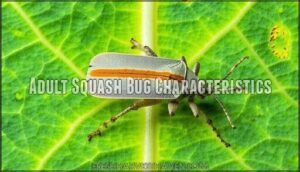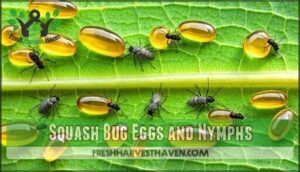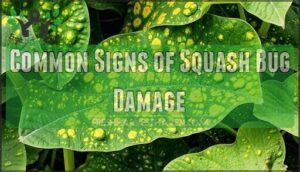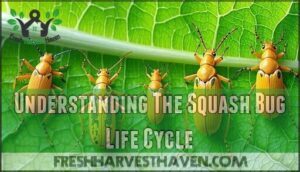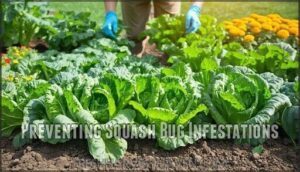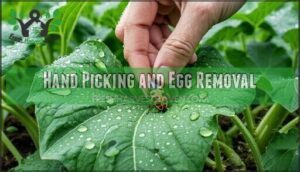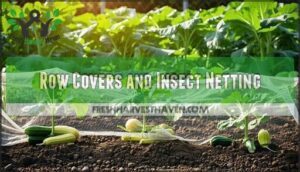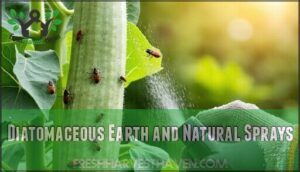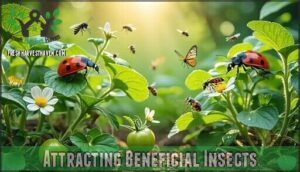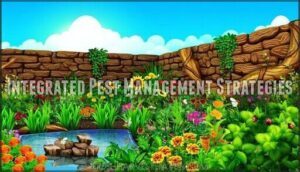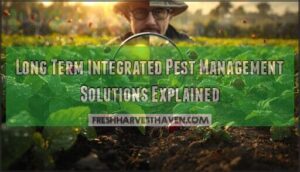This site is supported by our readers. We may earn a commission, at no cost to you, if you purchase through links.
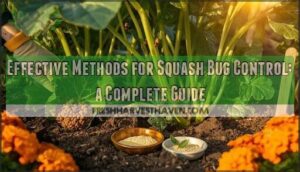
Rotate your crops, plant resistant varieties, and throw in marigolds or Thai basil for good measure. Row covers and diatomaceous earth are your armor; neem oil is your sword.
Layer your tactics, watch for nymphs, and don’t let up—squash bugs thrive on neglect. Ready for the nitty-gritty? There’s a whole arsenal waiting in the sections ahead.
Table Of Contents
- Key Takeaways
- How to Identify Squash Bugs
- Understanding The Squash Bug Life Cycle
- Preventing Squash Bug Infestations
- Organic and Physical Control Methods
- Integrated Pest Management Strategies
- Frequently Asked Questions (FAQs)
- What is the best pest control for squash bugs?
- How do I permanently get rid of squash bugs?
- How do farmers control squash bugs?
- What do squash bugs hate?
- How do I get rid of squash bugs?
- how do I prepare yellow squash?
- How do I protect my squash plants from Bugs & nymphs?
- Can you use organic pesticides to control squash bugs?
- How do I get rid of Hubbard squash bugs?
- How do you get rid of squash bugs at night?
- Conclusion
Key Takeaways
- Spot shield-shaped adults and bronze eggs early, then remove them by hand before they multiply. – Rotate crops each year and plant resistant squash varieties to break the squash bug life cycle. – Use row covers and diatomaceous earth as physical barriers, reapplying after rain for best results. – Keep your garden clear of debris and weeds, since messy beds give squash bugs a place to hide and thrive.
How to Identify Squash Bugs
You can’t manage what you can’t see, and squash bugs are masters at staying under the radar until it’s too late.
Spotting these flat-backed troublemakers early—whether they’re bronze-striped adults, rusty egg clusters, or gray nymphs—gives you the upper hand before they turn your squash patch into a wilted mess.
Adult Squash Bug Characteristics
If you’ve ever caught a glimpse of a flat-backed, shield-shaped intruder skulking around your squash patch, you’ve probably met Anasa tristis—the adult squash bug, and honestly, one of the most frustrating pests you’ll deal with in the garden.
Here’s what to look for when you’re hunting these critters:
- Size and color: Adults stretch about 5/8 inch long, with a grayish-brown body and distinctive orange or orange-brown stripes along the edges of their abdomen
- Wing morphology: They’ve got fully developed wings that lie flat against their backs, forming that telltale "X" pattern when folded
- Feeding habits: You’ll spot them piercing plant tissue with their needle-like mouthparts, literally sucking the life out of your squash leaves
- Overwintering adults: These survivors emerge from hiding spots in spring, ready to feed and start their mating behavior cycle all over again
Squash bug identification gets easier once you know what you’re looking at—trust me, after one season of battle, you won’t forget that shield-shaped profile.
Squash Bug Eggs and Nymphs
Those tiny bronze clusters hiding under your squash leaves aren’t decorative—they’re squash bug eggs waiting to set loose an army of sap-sucking troublemakers on your plants. You’ll find these egg masses in neat rows, usually containing 15-20 eggs each. When they hatch after 10 days, gray nymphs emerge and immediately start feeding.
| Stage | Appearance |
|---|---|
| Fresh Eggs | Shiny bronze ovals in clusters |
| Hatching Eggs | Darker brown, split open |
| Young Nymphs | Gray with black legs |
| Mature Nymphs | Darker gray, wingless |
These nymphs are your vulnerable stages—easier to control than adults since they can’t fly away yet.
Common Signs of Squash Bug Damage
Your once-thriving squash plants don’t lie when they start looking like someone’s been poking holes in them with a tiny ice pick. Those telltale yellow spots scattered across leaves quickly turn brown and crispy—classic squash bug damage.
As nymphs and adults feed, you’ll notice wilting plants, stunted growth, and eventually vine decline that can kill younger plants outright.
Understanding The Squash Bug Life Cycle
Knowing when squash bugs are active and vulnerable gives you the upper hand in this ongoing battle. Their predictable life cycle reveals the perfect windows for attack, from overwintering hideouts to egg-laying marathons that can make or break your control efforts.
Seasonal Activity and Overwintering
Imagine this: while you’re enjoying summer evenings on the patio, squash bugs are plotting their winter survival strategy like tiny armored generals preparing for battle. These resilient pests hunker down in garden debris, under boards, and in protected spots, waiting for spring’s warmth to trigger their emergence and the start of another destructive squash bug life cycle.
Here’s what drives gardeners crazy about their Overwintering Habitats:
- They’re hiding everywhere – Adults squeeze into mulch piles, fence cracks, and anywhere that offers Spring Emergence protection
- Climate Impact means longer seasons – Warmer winters let more survive, creating bigger populations when Egg-Laying Triggers activate
- Generation Overlap chaos – Late-season nymphs and overwintering adults create unpredictable timing for your control efforts
Egg Laying and Development Stages
Female squash bugs usually deposit clusters of 18-20 bronze-colored eggs on leaf undersides, laying up to 250 eggs over several weeks. These eggs hatch in 7-10 days under normal summer conditions.
Newly emerged nymphs cluster together initially, then progress through five developmental stages over 25-48 days before becoming adults. Understanding this squash bug biology helps you time your control efforts effectively. They’re a common pest, especially on squash and pumpkins.
How Life Cycle Impacts Control Timing
Knowing when squash bugs are most vulnerable is like having the enemy’s playbook—timing your attacks right can mean the difference between a few dead bugs and actually winning the war. Here’s when to strike:
- Early spring: Target overwintering adults before they lay eggs
- Egg hatch timing: Hit nymphs within 10 days when they’re soft and defenseless
- Mid-summer: Watch for generation overlap when both stages are present
Your squash bug management strategy needs to adapt as their life cycle unfolds—miss these windows, and you’re fighting an uphill battle.
Preventing Squash Bug Infestations
Prevention beats playing defense against these persistent pests every single time. Smart gardeners focus on four key strategies—crop rotation, resistant varieties, companion plants, and spotless garden hygiene—to stop squash bugs before they become your summer nightmare.
Crop Rotation Techniques
Moving your squash around the garden like musical chairs isn’t just good housekeeping—it’s one of the most effective ways to break the squash bug’s predictable routine and leave them scrambling to find their favorite dining spots.
These cultural control methods work because squash bugs overwinter in nearby soil and debris, expecting their host plants to return to the same spot. When you rotate crops to different garden areas each year, you’re forcing overwintering adults to travel farther to find food, which weakens their populations considerably.
Planting Resistant Squash Varieties
While genetic resistance won’t solve everything, it’s your best first line of defense. Butternut squash and other Cucurbita moschata varieties consistently outperform the common summer squashes in trials—some yielding nearly 10 fruit per plant even under pest pressure.
Look for ‘Royal Acorn’, ‘Sweet Cheese’, or newer releases like ‘Tromboncino’ from breeding programs targeting pest tolerance. These winter squash varieties have tougher stems that squash bugs struggle to penetrate.
Gardeners can also explore disease resistant options to improve their squash yields.
Companion Planting Strategies
If you think squash bugs are tough cookies on their own, wait until you discover how certain companion plants can turn your garden into their worst nightmare.
Marigolds and Thai basil create aromatic barriers that confuse these pests, while trap crops like blue Hubbard squash lure them away from your prized plants.
Strategic companion planting techniques involve weaving repellent herbs throughout your garden layout, creating natural diversification that disrupts their feeding patterns.
Garden Cleanup and Hygiene
Here’s the dirty little secret that most gardening guides won’t tell you: squash bugs are basically professional squatters, and your messy garden is their five-star hotel. These pests love nothing more than cozy hiding spots in plant debris and weeds where they can overwinter comfortably, then emerge ready to devastate your cucurbit crops.
Essential Garden Sanitation Steps:
- Debris Removal – Clear all dead plant material, fallen leaves, and crop residues immediately after harvest to eliminate overwintering sites
- Weed Control – Maintain weed-free zones around squash plantings, as many weeds serve as alternative hosts for squash bug populations
- Soil Sanitation – Till or cultivate soil in fall to expose and destroy any hidden eggs or pupating insects
- Garden Tools – Clean and disinfect all equipment between garden areas to prevent accidentally transporting eggs or nymphs
- Yard Waste – Compost plant materials properly at high temperatures, or dispose of infested debris away from growing areas
Organic and Physical Control Methods
When chemicals aren’t your thing, physical and organic methods can knock squash bugs down to size—though you’ll need to stay on top of them like a hawk.
These hands-on approaches work best when you catch the problem early and stick with your game plan through the growing season.
Hand Picking and Egg Removal
Picture yourself as a squash bug bounty hunter, because that’s exactly what you’re about to become when you start hand-picking these stubborn pests off your plants. Understanding the squash bug life cycle makes your squash plant monitoring more effective. These physical control methods require persistence, but they’re your best defense against building resistant populations that laugh at chemical sprays.
This manual control method works best during early morning bug inspection when adults move sluggishly. Focus your pest eradication efforts on egg mass removal from leaf undersides, where females deposit bronze-colored clusters.
| Target | Location | Best Timing | Action |
|---|---|---|---|
| Adult bugs | Stems, leaves | Early morning | Hand pick into soapy water |
| Egg masses | Leaf undersides | Daily checks | Scrape off with fingernail |
| Nymphs | Base of plants | Mid-morning | Crush or collect |
| Overwintering adults | Garden debris | Fall cleanup | Remove hiding spots |
Row Covers and Insect Netting
Row covers act like armor for your squash plants, creating an impenetrable barrier that keeps persistent bugs from ever reaching your precious vines. Use lightweight garden fabric or insect netting over young plants—these physical barrier methods block adults from laying eggs while still allowing sunlight and water through.
Just remember to remove covers once flowers appear, or your crop protection systems will prevent pollination too.
Diatomaceous Earth and Natural Sprays
Diatomaceous earth works by shredding the exoskeleton of squash bugs, causing them to dehydrate—but here’s the catch: it only kills when dry. Rain or heavy watering wipes out its effectiveness, dropping control rates below 20%.
You’ll need to reapply DE after every rainfall, focusing on lower stems and leaf surfaces where nymphs cluster. Pair it with neem oil or pyrethrin-based natural sprays for better results; studies show this combo boosts mortality by 25%.
Food-grade DE is your safest bet for organic control in home gardens.
Attracting Beneficial Insects
Nature’s got your back on this one, and recruiting the right predators can turn the tide in your favor without you lifting a finger.
Focus on Insectary Plants like marigolds and Thai basil to create Beneficial Insect Habitats that draw in pollinators and predators—tacit spiders, ground beetles, and parasitic wasps that’ll hunt squash bugs.
This Natural Pest Control approach restores Biological Balance in your Pollinator Gardens, giving you backup that actually works.
Integrated Pest Management Strategies
Look, if you’ve been battling squash bugs for more than one season, you know that no single trick is going to save your plants.
You need a game plan that combines the best tactics and adjusts as the bugs (and your garden) change. Integrated Pest Management isn’t about picking one method and hoping for the best; it’s about layering your defenses, keeping a close eye on what’s actually happening out there, and staying flexible enough to switch gears when something isn’t working.
Monitoring and Early Detection
You can’t fight what you can’t see, and squash bugs are masters at hiding until they’ve already done their damage. That’s why weekly plant inspection is your best defense—check the undersides of leaves for those telltale bronze egg clusters and watch for wilting as an early warning sign.
Seasonal scouting from spring onward helps you catch these pests during their vulnerable nymphal stages, when your squash bug control strategies actually work. Detection methods don’t need to be fancy; just consistent monitoring gives you the upper hand in pest identification and control before squash bug damage becomes irreversible.
Combining Multiple Control Methods
No single tactic will knock out squash bugs on its own, but layering your defenses can shift the odds back in your favor. Think of integrated pest management as weaving a tight net—crop rotation disrupts their winter hideouts, hand-picking cuts down adults before they breed, and row covers block newcomers entirely.
When you pair cultural controls with diatomaceous earth or selective insecticides, you’re building a multi-layered defense that targets every weak point in their life cycle, giving your squash a real fighting chance.
Adjusting Tactics Throughout The Season
Squash bug control isn’t something you can set and forget—what works in June might leave you scrambling by August if you don’t adapt. Seasonal monitoring matters because nymphs hatch in waves, and your timing strategies need to shift accordingly.
Early-season cultural controls like hand-picking become less effective as populations explode, so you’ll need tactical adjustments—maybe adding diatomaceous earth or ramping up trap crop inspections. Environmental factors like temperature spikes can accelerate development, turning a manageable insect infestation into a full-blown nightmare if you’re not paying attention.
Safe Use of Selective Insecticides
When hand-picking and trap crops aren’t cutting it, selective insecticides offer targeted relief—but only if you use them right. Here’s what actually works:
- Novaluron cuts nymph populations by 80% with minimal pollinator toxicity
- Flupyradifurone kills nymphs while sparing egg parasitoids
- Pyrethroids deliver 60–75% mortality but resistance develops within three years
- Rotate modes of action each season—it delays resistance buildup by 135%
- Apply outside bloom periods and follow the 12-hour re-entry interval
Soil-applied neonicotinoids lose efficacy after eight weeks, and repeated Pyrethroid applications breed resistance fast. Check your state’s extension guidelines for application rates and drift reduction requirements near sensitive habitats.
Frequently Asked Questions (FAQs)
What is the best pest control for squash bugs?
Like a game of cat and mouse, managing squash bugs takes a mix of organic pest management, pest traps, and Biological Controls.
Chemical Sprays and Soil Treatment help, but Organic Pesticides often win for insecticide effectiveness.
How do I permanently get rid of squash bugs?
Let’s be honest—there’s no magic trick to wipe out squash bugs for good. Instead, your best bet is to mix and match bug barriers, plant protection, and long-term prevention.
Here’s how you can manage them organically:
| Method | Best For |
|---|---|
| Hand-picking | Small gardens |
| Row covers | Early season defense |
| Resistant varieties | Managing squash bugs |
| Selective insecticides | Insecticide effectiveness |
How do farmers control squash bugs?
Picture a farmer in Kansas, checking leaves at dawn—she relies on pest monitoring, targeted insecticide application, and strict farm sanitation.
Here are three top strategies:
- Biological Controls
- Chemical Sprays
- Soil Management
What do squash bugs hate?
Catching squash bugs off guard means using Repellent Plants like marigolds, boosting Soil Health, and encouraging Natural Predators.
Trap Cropping with blue Hubbard squash, plus environmental factors like clean gardens, all frustrate their pest control ambitions.
How do I get rid of squash bugs?
During peak squash bug season, pest control means getting creative with pest management. Try Bug Vacuuming, set up Trap Cropping, and spray Insecticidal Soap. For extra punch, encourage Parasitic Wasps or experiment with Soil Solarization.
- Bug Vacuuming removes adults and nymphs quickly. – Trap Cropping lures squash bugs away from main plants. – Insecticidal Soap targets vulnerable nymphs and eggs.
how do I prepare yellow squash?
If you’re staring down a pile of yellow squash from your garden, here’s how to prep: wash, slice, and choose your cooking method—grill, sauté, roast, or steam. Check out the table for details:
| Cooking Method | Recipe Ideas | Storage Tips |
|---|---|---|
| Grilled | Squash kabobs | Refrigerate whole |
| Sautéed | Stir-fry, hash | Use within 4 days |
| Roasted | Sheet pan veggies | Slice, freeze |
| Steamed | Simple side dish | Blanch, freeze |
| Raw | Salads, dips | Store in crisper |
How do I protect my squash plants from Bugs & nymphs?
To prevent squash bugs and nymphs, prevention is key. Focus on bug barriers, early intervention, nymph prevention, trap cropping, and solid cultural control for healthy cucurbit crops.
Can you use organic pesticides to control squash bugs?
Yes, you can use organic pesticides like Neem oil or Diatomaceous earth Celite 610 for squash bugs, but results vary.
Try mixing safe ways to apply these treatments with homemade sprays and some natural pest control. This helps keep your soil healthy and makes organic pesticides work even better.
How do I get rid of Hubbard squash bugs?
If Hubbard squash bugs keep sneaking in, try Hubbard bug traps and hand picking nymphs.
Targeted insecticide use works best when you time it with the Hubbard life cycle.
You can also look into commercial solutions or call in a professional if you need extra help.
How do you get rid of squash bugs at night?
Using Nighttime Bug Behavior to your advantage, you can deploy Nocturnal Removal Tactics like hand picking squash bugs, nymphs, and egg masses, Nighttime Trapping, Nighttime Spraying, and Nighttime Monitoring—boosting cultural control measures while they’re most active.
Conclusion
Sometimes, the smallest pests demand the biggest battles—there’s the paradox. Effective methods for squash bug control aren’t magic, but they do require vigilance and layered tactics.
Spotting shield-shaped adults, removing eggs, and keeping your garden clean all add up. Rotate crops, use row covers, and don’t forget those companion plants.
If you stay stubborn and sharp-eyed, you’ll turn the tide. Master these strategies, and you’ll keep your squash safe season after season.
- https://www.growjourney.com/prevent-stop-squash-vine-borers/comment-page-4/
- https://uknowledge.uky.edu/cgi/viewcontent.cgi?article=1256&context=entomology_facpub
- https://attra.ncat.org/wp-content/uploads/2022/08/squash-bug-and-squash-vine-borer.pdf
- https://projects.sare.org/project-reports/ls20-337/
- https://pmc.ncbi.nlm.nih.gov/articles/PMC9122185/

